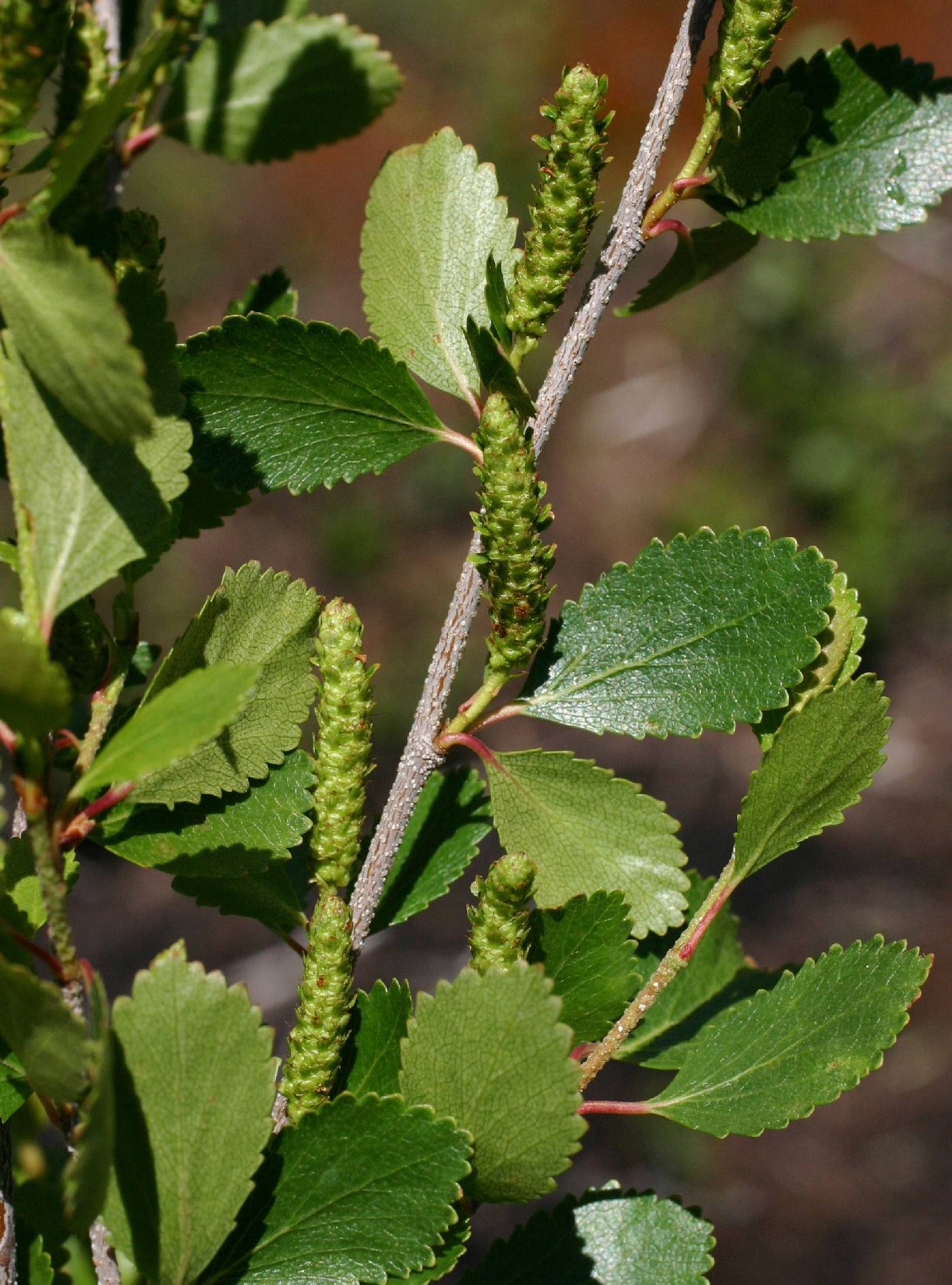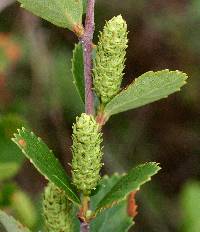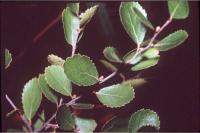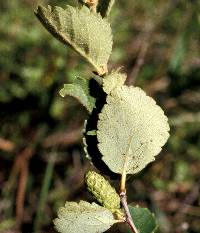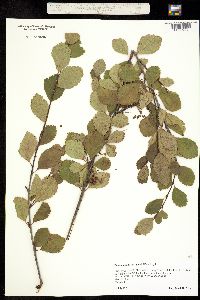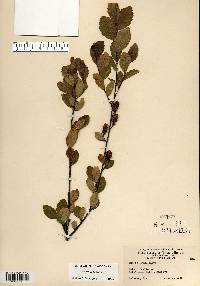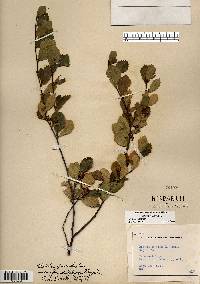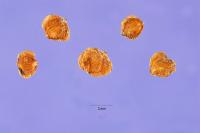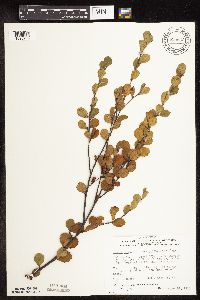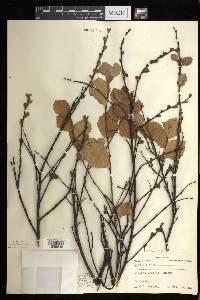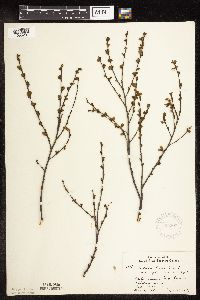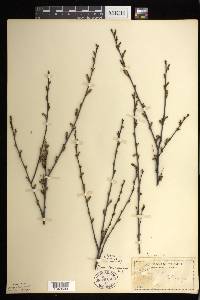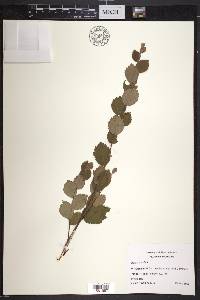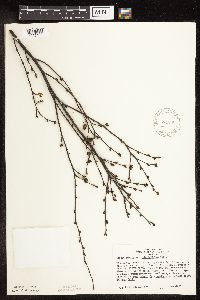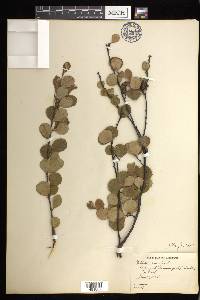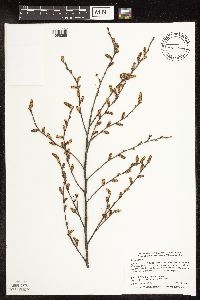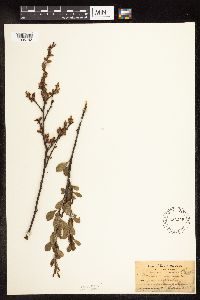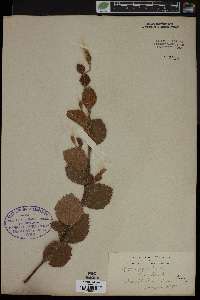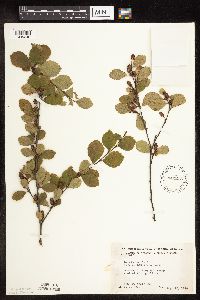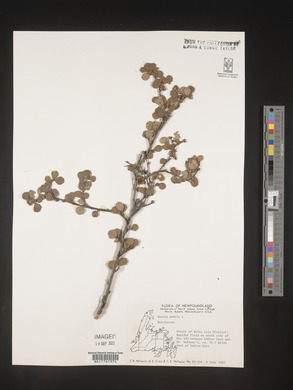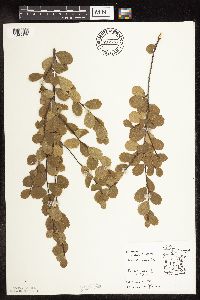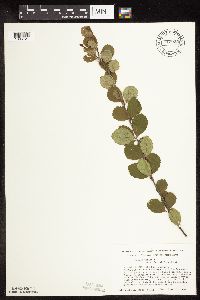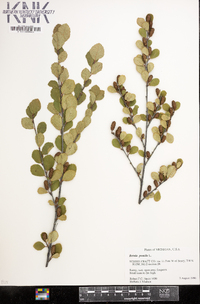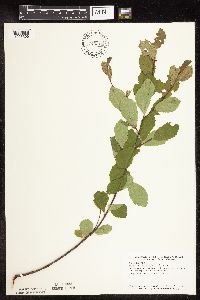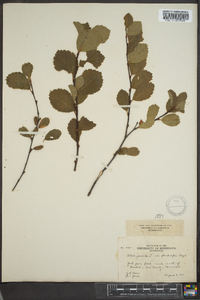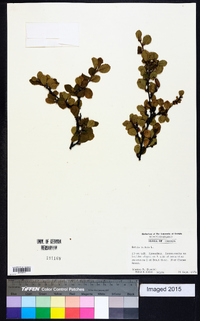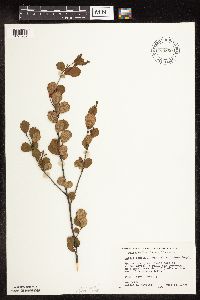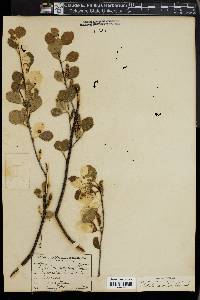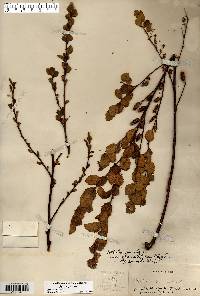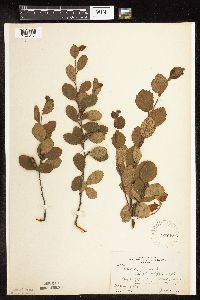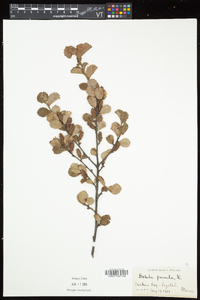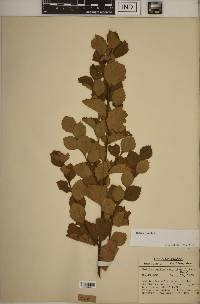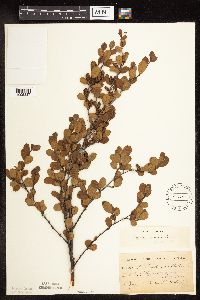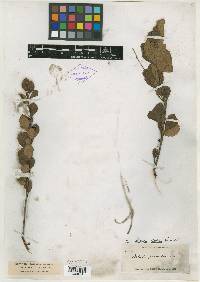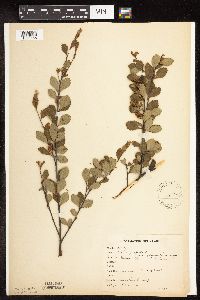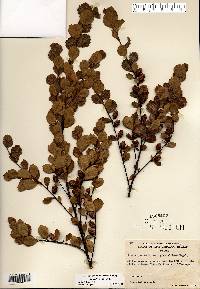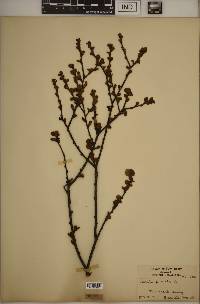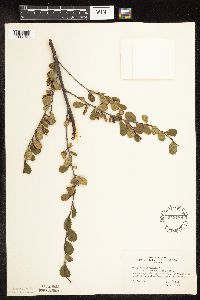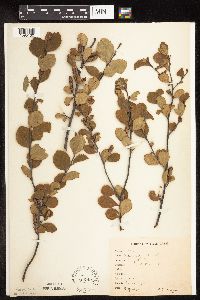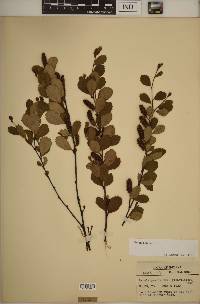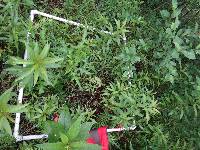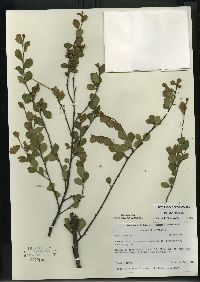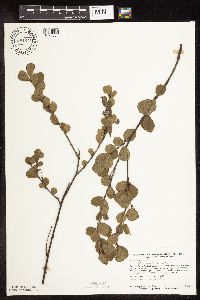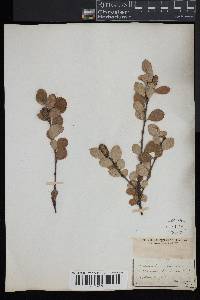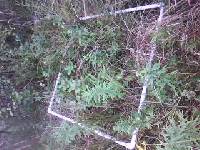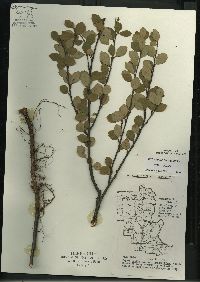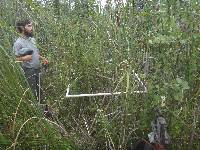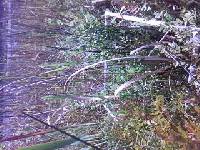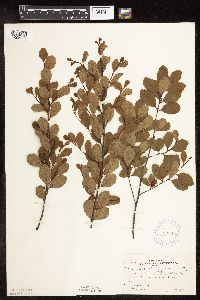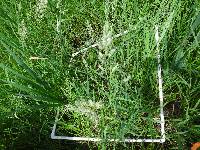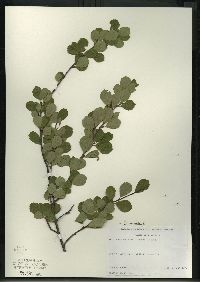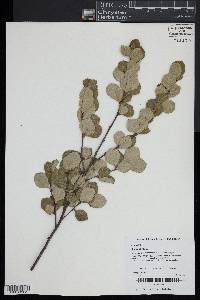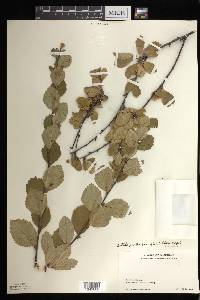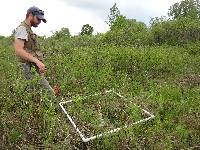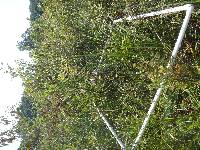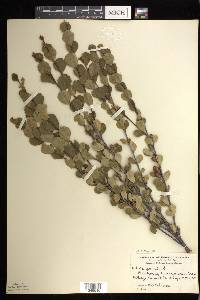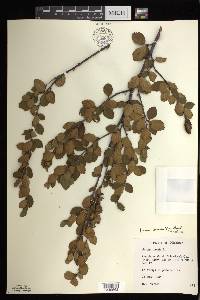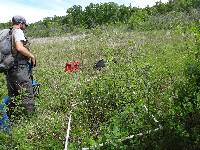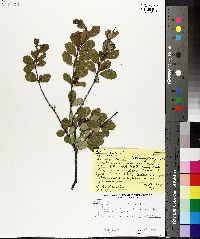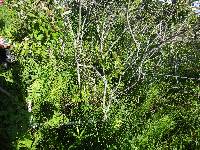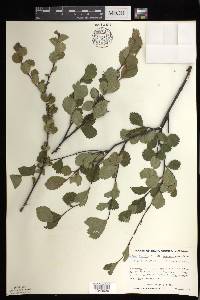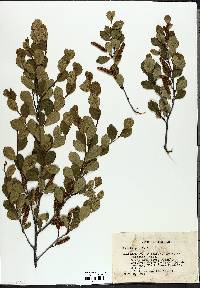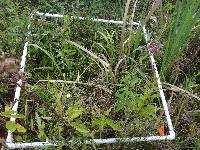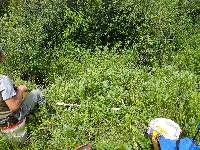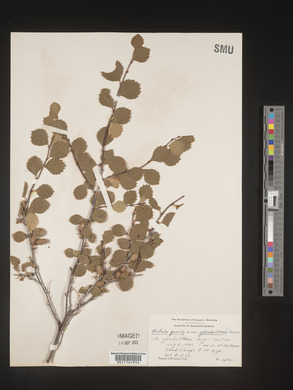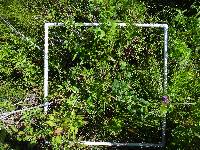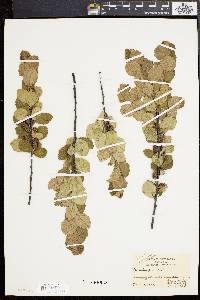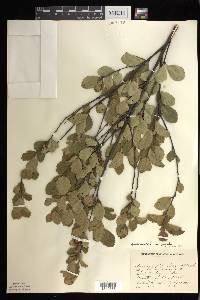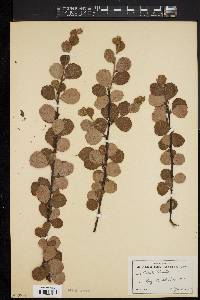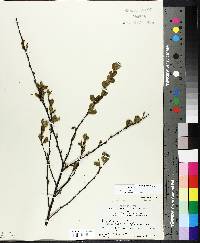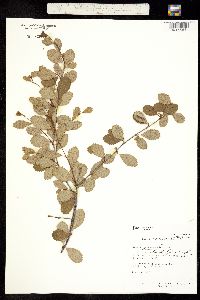
|
|
|
|
Family: Betulaceae
Bog Birch, more...dwarf birch
[Betula hallii] |
Shrubs , coarse, irregular, or spreading, to 4 m. Bark dark reddish brown, smooth, close; lenticels pale, inconspicuous. Twigs without taste and odor of wintergreen, glabrous to moderately pubescent, with scattered small resinous glands, especially near nodes. Leaf blade elliptic, obovate, or nearly orbiculate (to sometimes reniform) with 2--6 pairs of lateral veins, 2.5--5(--7) × 1--5 cm, base cuneate to rounded, margins crenate to dentate, apex usually broadly acute or obtuse to rounded; surfaces abaxially glabrous or slightly pubescent to heavily velutinous or tomentose, often with scattered resinous glands. Infructescences erect, cylindric, 0.8--1.5(--2) × 0.8--1 cm, shattering with fruits in fall; scales glabrous to pubescent, lobes diverging slightly distal to middle, central lobe narrow, elongate, lateral lobes shorter and broader, extended. Samaras with wings slightly narrower than body, broadest near center, not extended beyond body apically. 2 n = 56. Flowering late spring. Bogs, calcareous fens, wooded swamps, muskegs, lake shores; 0--700 m; St. Pierre and Miquelon; Alta., B.C., Man., N.B., Nfld., N.W.T., N.S., Ont., P.E.I., Que., Sask., Yukon; Calif., Colo., Conn., Idaho, Ill., Ind., Iowa, Kans., Maine, Mass., Mich., Minn., Mont., Nebr., N.J., N.Y., N.Dak., Ohio, Oreg., Pa., S.Dak., Vt., Wash., Wis., Wyo. Betula pumila is sometimes treated (in part) as a variety of B . glandulosa Michaux, to which it is related at a subgeneric or sectional level. On the basis of morphology, however, it forms a cohesive and distinct entity (J. J. Furlow 1984). The two main varieties into which B . pumila is often divided (a more southern B . pumila var. pumila , with mostly pubescent, glandless leaves, and a more northern B . pumila var. glandulifera , with less pubescent, gland-bearing leaves) may represent geographic races; these are not well marked, however, and they do not hold up well when the complex is examined as a whole. The Ojibwa used Betula pumila medicinally as a gynecological aid and as a respiratory aid (D. E. Moerman 1986).
Shrub to 4 m tall Leaves: alternate, short-stalked, 2.5 - 5 cm long, 1 - 5 cm wide, elliptic to almost round with a wedge-shaped to rounded base and pointed to rounded tip, usually round-toothed, smooth to densely hairy and usually dotted with resinous glands beneath, with three to six pairs of lateral veins. Flowers: either male or female, found on the same tree (monoecious), borne in catkins, male catkins hanging, female catkins upright. Fruit: a seed surrounded by somewhat narrow wings (samara), borne in upright catkins 1 - 2 cm long and falling apart when seeds ripen in the fall. Scales are three-lobed, cross-shaped, and sometimes hairy. Twigs: dark reddish brown, smooth to moderately hairy, with tiny resinous glands often close to the nodes. Similar species: This is the only species of birch in the Chicago Region that is a shrub. The leaves are up to 5 cm long and rounded or slightly pointed at the tip. Hybrids with Betula alleghaniensis (Betula x purpusii) and Betula papyrifera (Betula x sandbergii) can also be shrub-like, but have features intermediate of the two parents. Betula x purpusii has twigs that smell like wintergreen when scratched and three ascending lobes on the fruit scales. Flowering: late April to late May Habitat and ecology: Forms colonies in bogs with acid or alkaline soil. There is a loss of these bog habitats in the Chicago Region, with the largest populations occurring in the Wisconsin Counties of the region. Occurence in the Chicago region: native Etymology: Betula is the Latin name for birch. Pumila comes from the Latin word meaning dwarf, referring to its form. Author: The Morton Arboretum Erect, branching shrub 1-4 m, with close, brown bark; lvs firm, obovate to broadly ovate or orbicular, 2-3 cm, obtuse to broadly rounded above, coarsely dentate, rounded to broadly cuneate at base, softly pubescent on both sides when young, glabrescent with age, the hairs mostly 1-2 mm; lateral veins 3-6 pairs, the veinlets conspicuously raised-reticulate; fruiting catkins 1-2 cm, on peduncles 5-10 mm; scales 2.8-5.5 mm, about as wide, the lateral lobes widely divergent, often constricted at base; frs depressed-obovate to subrotund or oblate, truncate or rounded above, 1.6-2.8 נ1.8-3.7 mm, the body half as wide as the whole fr; 2n=56. In bogs, often forming large colonies; Nf. and Que. to s. Ont. and Mich., s. to N.J., Md., c. O., and n. Ind. Gleason, Henry A. & Cronquist, Arthur J. 1991. Manual of vascular plants of northeastern United States and adjacent Canada. lxxv + 910 pp. ©The New York Botanical Garden. All rights reserved. Used by permission. From Flora of Indiana (1940) by Charles C. Deam Restricted to the lake area where it is found in bogs and marshes. Infrequent to rare. It is to be noted that the under surface of the leaves of all of my specimens is glaucous. The variety [glandulifera] differs from the species in that the young branchlets, leaves, and bracts are covered more or less with glandular dots or resinous glands. In our area, the distinction is not always clear since in the same clump of shrubs one can often find some densely resinous specimens and others with only a minute amount of resin. ...... Indiana Coefficient of Conservatism: C = 10 Wetland Indicator Status: OBL |

